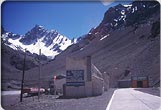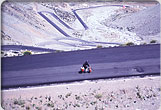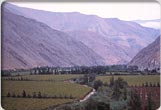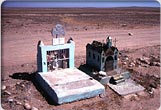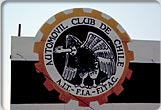| El Libertador/Las Cuevas to Antofagasta |
| Chile is entered through the El Libertador/Las Cuevas tunnel for bicycles (picture shows Chilean side) - a disused railway tunnel that parallels the road tunnel. The bike tunnel is three or four kilometres long with paving blocks on the Argentine side and tarmac on the Chilean side. It's lit all the way through, though I met one cyclist who had to walk the Chilean half in the pitch black. Once out of the tunnel there's a short downhill run to the customs post, then a screaming downhill past the Portillo ski resort and into the Caracoles (picture) - a fantastic collection of switchbacks that were freshly resurfaced in 1998. The road is downhill (2400 vertical metres) almost all the way to Los Andes, a hospitable town and home to Eric Savard a man, who together with his family, shows great generousity to passing ciclistas. He's a legend amongst touring cyclists. 2005 update - I don't know if the railway tunnel is still open to cyclists as quite a few recent cycling travelogues have mentioned that they had to arrange vehicle lifts through the road tunnel. Some even said this was offered as a free service with a vehicle at the ready to shuttle bikes in both directions. In better news the Chileans have now restored (de-mined?) the old dirt road over the Cristo Redentor Pass. This will mean you can cycle even higher and avoid the long tunnels entirely (other than a short tunnel on the Argentine side near Las Cuevas). Pictures of the pass and more details on the masterlyinactivity.com website of Tracey Maund and Colin Champion. A eccentric small roadside cafe at the midway point between the pass and Los Andes is a frequent camping spot for cyclists on their way up. It has an interesting guest book, and the owner will tell you how to find Eric Savard if you stop at the cafe on the way down. Diary entry for the day reads: "Mountains simply fucking incredible." |
| From Los Andes I head North into ever drier terrain. On the first day I cover around 100 kilometres, a lot of that on a great but rough dirt road. I see 5 lazy snakes and have to actively avoid three of them. A lot of cacti were flowering. Goats seemed the most common livestock. I arrive in Cabildo after dark. It's been a long and tiring day and I grow increasingly frustrated after an hour of "helpful" locals telling me fictitious addresses for hotels. Why don't they just say they don't know? Oddly, three separate people, includeing a cop, give me the address of a vacant block. Maybe it used to be a hotel. In the end a lady overhears my asking a shopkeeper and escorts me to a an odd restaurant come dancehall, above which I finally find a room. My bike sleeps in the dancehall. I dreaded the thought of rejoining the Panamerican highway but in the event it was OK. The further north you get from Santiago, the thinner the traffic. Even this far south I refer to the traffic as 'light' in my diary. It is mostly well surfaced and wide with a decent hard shoulder for cycling. The road sticks close to the coast. The scenery is, well, coastal with rocky headlands, sandy beaches, sleepy off-season working class resort towns and an occasional sea fog. Beyond Los Vilos the hills begin. Most days between here and Bolivia involved around 1000m of climbing. Some days the climbs were short and sharp, but numerous. On other days the climb could be spread over the whole day and the tailwind made it effectively disappear. Oh those tailwinds. Flatula, the god of tailwinds sure smiles on cyclists heading north into the Atacama. Day after day of clockwork Sou' Westerly tailwinds..... In six weeks going North in the desert I had but a handful of headwind days, and all but two of them happened when I was returning west after there-and-back detours to places east of the highway (like San Pedro). Usually at about 10am a tailwind would spring up and push me along ALL day. This would have been a miserable ride if I were heading south. Actually it would have been a miserable bus ride. |
|
Traffic thins considerably beyond La Serena. Each day seems to carry less traffic than the one before. In the first 100km beyond La Serena there is 1400 vertical metres of climbing to be done. This sets the tone for the rest of the ride North. Some days the road is constantly up and down, sometimes a thousand metre vertical may be spread out over 100km and barely noticable. Vallenar (two days north of La Serena) failed to impress but the riding was excellent. The ride to Copiapo, next day was stunning and helped along by a rocketship tailwind early in the day. No hard shoulder for about 40km either side of Vallenar, though this may have changed in the years since my ride. Wildflowers were in abundance after a damp autumn. Other than a drenching sea fog on my first day out of La Serena, I didn't encounter rain again until La Paz in Bolivia two and a half months later. The further North you ride the less greenery. Once the highway leaves the coast at Chañarel, the sparse vegetation gives way to no vegetation. Not a blade of grass, no cactus, nothing. Huge skies and bare mountains. From this point the road climbs too and for most of its way North sits between 1,000 and 2,500 metres above sea level. Even in the tropics this keeps the temperature ideal for cycling most of the time. There is a newer coastal road for most of the way north, but my ride followed Ruta 5 the main inland road. Yes the scenery is desolate, beyond Chañarel, it is very desolate, but that's its beauty, yet every day I found something to interest me... Sometimes the shrines to crash victims - trees planted as memorials and kept alive by passing motorists upending lidless PET water bottles so that the water would slowly drain into the soil - or the elaborate tin cathedrals (picture, near La Serena) or circus tents (even clowns have gotta die) as memorials to others. Given the seemingly huge numbers of crash death memorials, it struck me as appropriate that the symbol of the Chilean Automobile Club was a Condor - a vulture. It peered from just a few too many billboards for my liking (the symbol, that is, not the real thing). That said, I never had a problem with Chilean drivers, they didn't seem noticeably worse than Australians. |
|
Home :: Santiago to Puerto Montt :: Isla Chiloe :: Carretera Austral :: Esquel to Mendoza :: Argentina to Antofagasta :: Around San Pedro :: San Pedro to Bolivia :: Bolivia :: Bolivia to Santiago
|
